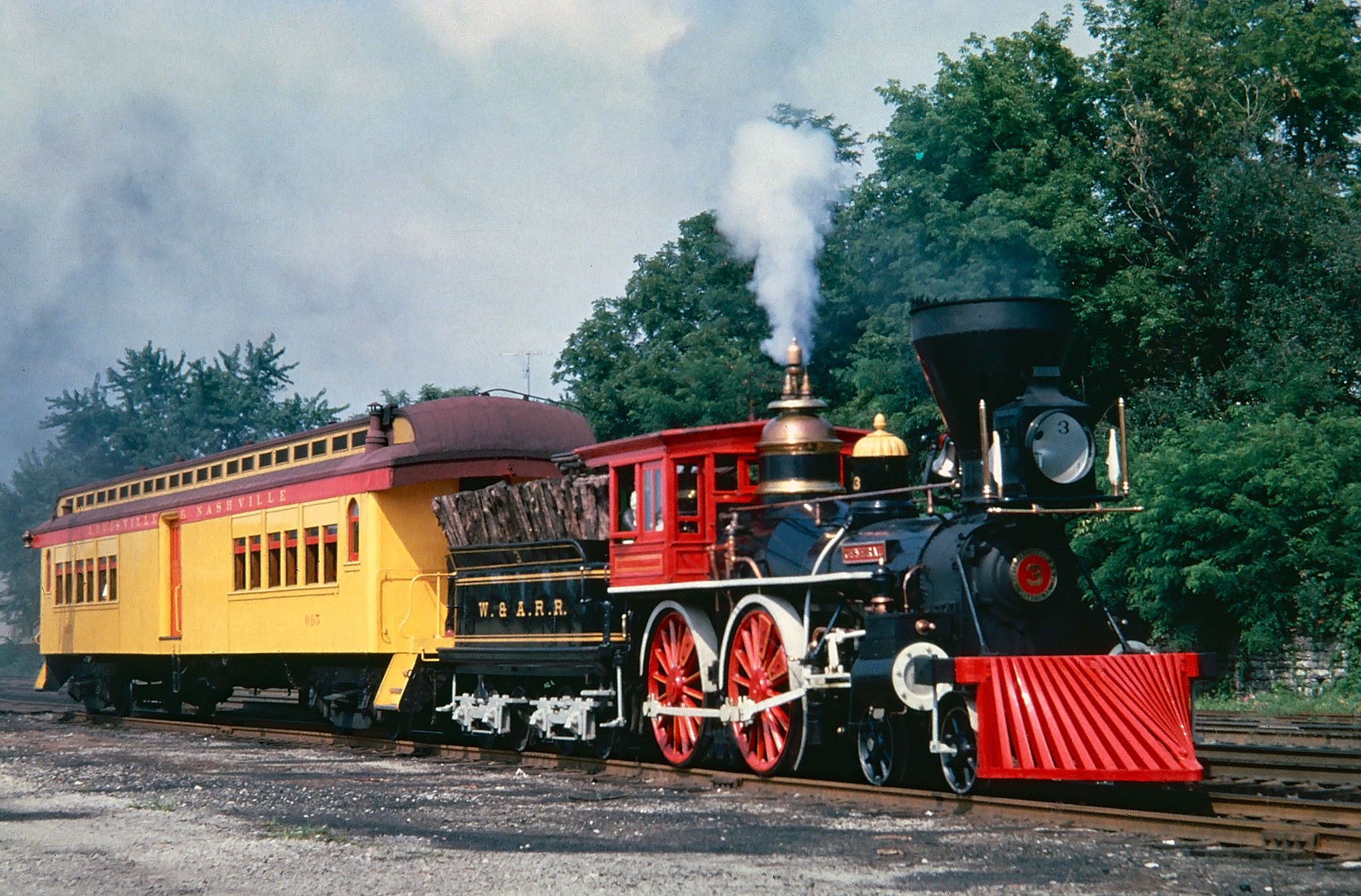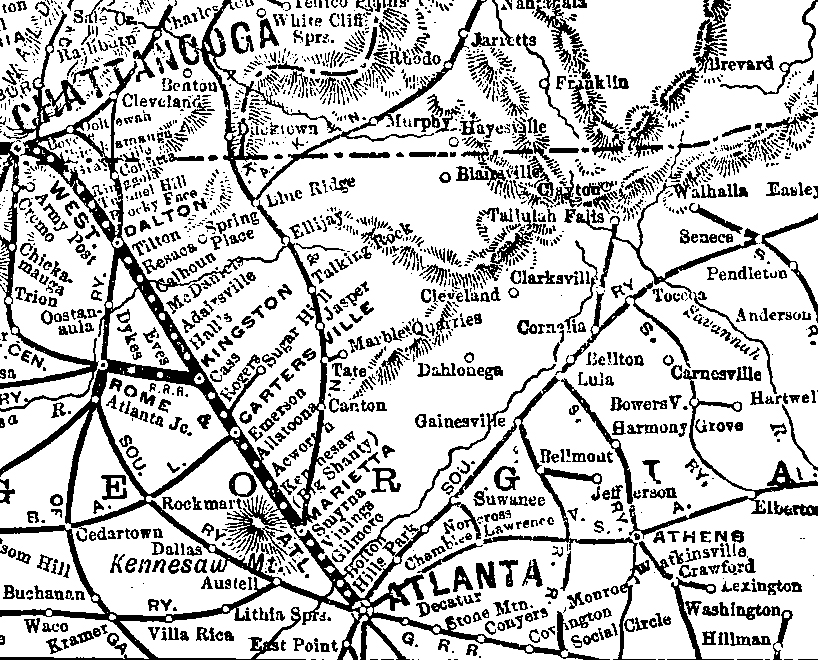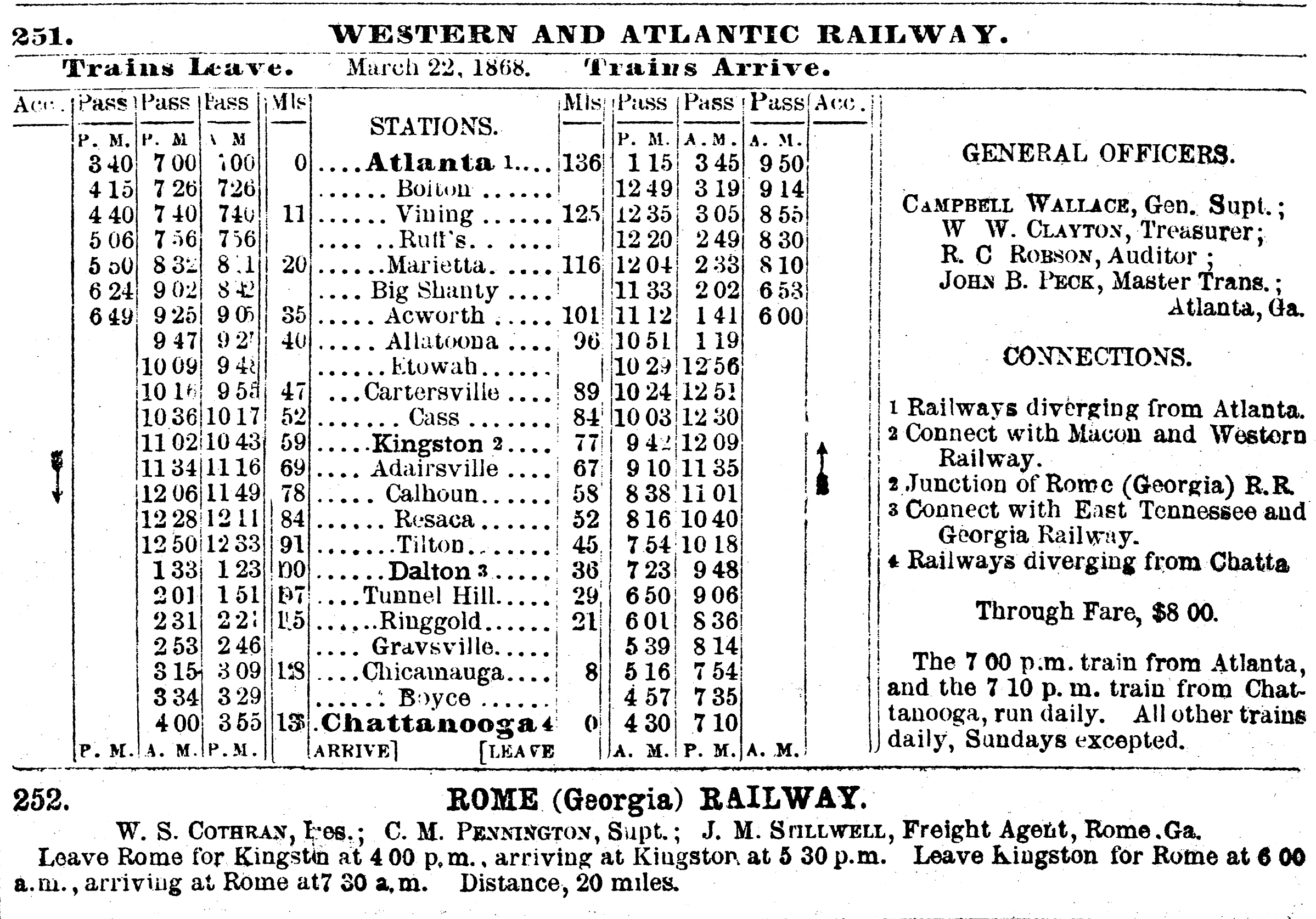Western and Atlantic Railroad: Map, History, Timetables
Last revised: February 28, 2025
By: Adam Burns
The Western and Atlantic Railroad (W&A), a historic name in American railway history, originated in the deep southern state of Georgia.
A key player in the development of transport infrastructure during the early years of the 19th century, the W&A revolutionized the transportation landscape of the Southern United States.
The railroad's genesis can be traced back to 1836, when the Georgia General Assembly chartered its construction.
With its north–south layout spanning its home state, the aim was to facilitate improved connectivity between the then underserved interior of the state and the town of "Terminus," which was later renamed Atlanta.
Serving Tennessee and Georgia, the Western and Atlantic initially focused on the Peach State, specifically aiding in an improved transportation network between the rural north and prosperous south. Subsequently, its system expanded, and eventually opened between Atlanta and Chattanooga, Tennessee.
The Western and Atlantic Railroad, stretching 137 miles, was no minor undertaking for its time. Built almost entirely by hand, the railway served a significant fraction of Georgia's territorial expanse, uniting distant towns and cities under a consolidated umbrella of improved transport accessibility.
The Civil War era marked a dramatic turn in the railroad's history. Its importance as a supply line for the Confederate army was firmly acknowledged, making it a crucial point of contention between the Union and Confederate forces. It was during this period that it featured in the infamous 'Great Locomotive Chase' in 1862.
This event was a military raid that took place in northern Georgia during which time Union Army volunteers commandeered a train and took it northward toward Chattanooga, Tennessee. Along the way the raiders carried out as much damage as possible to the W&A.
Post-Civil War, the Western and Atlantic underwent significant transformation as part of the larger changing dynamics of the railroad industry.
The increasingly complex network, coupled with financial and managerial challenges, eventually led to its acquisition by the Nashville, Chattanooga and St. Louis Railway (NC&StL) in 1890.
This event marked a new phase in the W&A's history, transitioning it from being state-owned to a key part of a larger, privately-owned railroad organization.
Modern ownership has subsequently passed to the Louisville & Nashville, and then CSX Transportation during the 1980s; the latter is one of the current Class I freight railroad operating in the eastern United States.
Despite numerous changes in management and operation throughout its existence, the original main line of the railroad continues to be a vital part of the railway infrastructure in Georgia.
The W&A, once a lifeline for the rural communities of Georgia via a main line cut through the rugged southern Appalachian Mountains, continues to fulfill its purpose, serving as a crucial stretch in the expanse of this vast network.
Photos
 Western & Atlantic 4-4-0 #3, the "General," and Louisville & Nashville combine #665, the "Jim Crow," host a photo special on the L&N in July, 1970. American-Rails.com collection.
Western & Atlantic 4-4-0 #3, the "General," and Louisville & Nashville combine #665, the "Jim Crow," host a photo special on the L&N in July, 1970. American-Rails.com collection.History
To appreciate the legacy of the Western and Atlantic to understand its driving force - the vision to connect, prosper, and advance.
Born from a need to link Georgia's agrarian interior with the burgeoning activity of the Atlantic, the W&A proved instrumental in forging a path of progress not just within the state, but across the broader southern United States.
What was then known as the Western & Atlantic Railroad of the State of Georgia (W&A) the company was officially formed by the Georgia General Assembly on December 21, 1836 to provide a connection from the port of Savannah to the Midwest.
The railroad was projected to run from Chattanooga, Tennessee, cut a line through the southern Appalachian Mountains, and terminate at a point in present-day Fulton County along the Chattahoochee River.
Engineers and surveyors proclaimed the railroad's final ending point as simply "Terminus." In 1842 this settlement was incorporated as Marthasville, which, by an act of the Georgia General Assembly became Atlanta in 1845.
At A Glance
5 Feet (12/24/1842 - 5/31/1886) 4 Feet, 8 ½ Inches (6/1/1886 - 1890) | |
The W&A's Zero Milepost was driven at what became Forsyth and Magnolia Streets, which was later moved in 1842. For years, the stone marker was held at the Georgia Building Authority. In 2018, however, it was moved to the Atlanta History Central.
The railroad was originally built to the wide, "Southern" gauge of 5 feet. By the late 1840s the project was largely complete; only a 1,447-foot tunnel driven through Chetoogeta Mountain connecting Dalton to Ringgold, Georgia remained.
It was the first railroad tunnel completed south of the Mason-Dixon line and opened on May 9, 1850. The W&A's gauge remained at 5 feet until 1886 when, during a single day, between May 31st and June 1st, the entire 138 mile route was regauged to 4 feet, 8 ½ inches.
The Western and Atlantic played an instrumental role during the Civil War, a period that shook the foundations of American economy and society.
The system was a supply line of the Confederate Army and, as a result, became a strategic military target for Union forces seeking to disrupt Confederate supply lines.
Its prominence during the conflict was firmly established through the infamous "Great Locomotive Chase," a high-profile military escapade as thrilling as it was game-changing.
As Confederate and Union forces sought control over it, the W&A witnessed—and impacted—some of the war’s most critical events.
On April 12, 1862, the "Great Locomotive Chase" emerged as an audacious, unprecedented military operation.
Union spies, led by civilian scout James J. Andrews, hijacked a locomotive, "The General," on the W&A line in Big Shanty, Georgia. Their objective was to puncture the supply line - by destroying tracks, bridges, and telegraph lines along the way to Chattanooga, Tennessee.
System Map
The "Great Locomotive Chase" unfolds as a gripping tale of cat-and-mouse, marked by daring exploits, strategic counter-thrusts, and high-stakes tension.
The Union spies, despite their initial success, were eventually captured when the Confederate train crew, led by conductor William A. Fuller, hijacked a second locomotive, "The Texas," and pursued "The General."
The aftermath of the chase was equally dramatic, resulting in severe punishment for many Union spies, including Andrews.
This event etched the Western and Atlantic into the annals of Civil War history, notwithstanding its pivotal role in numerous other war-related operations.
Post-Civil War, the W&A confronted a tide of transformations, given the reorientation of economic and geographical considerations. A large part of the railroad’s post-war adjustments centered around financial restructuring and strategic recalibration.
In his book, "Nashville, Chattanooga & St. Louis: A History Of 'The Dixie Line,'" author Dain Schult notes the W&A was sold to private interests in 1871 and renamed as the Western & Atlantic Railroad Company.
The late 19th century marked a pivotal turning point in the company's story, as it was procured by the Nashville, Chattanooga and St. Louis Railway (NC&StL) in 1890.
This acquisition came on the heels of deepening political and economic linkages between the Southern states, as they collectively forged the path to recovery and prosperity post-war.
The integration expanded the reach and capacity of the NC&StL, providing the railroad access to the Atlanta market.
Timetable (1868)
The railroad’s acquisition by the NC&StL led to numerous transformative actions, including restructuring of routes, modernization of infrastructure, and enhancement of operational strategies.
These developments repositioned the Western and Atlantic within an ever-evolving landscape of progress and innovation.
The modern era witnessed further transitions in the W&A's operational control. Using sly business tactics the larger Louisville & Nashville managed to gain stock control of the NC&StL in January of 1880.
As the railroad landscape underwent sweeping changes, the L&N merged into the Seaboard System in 1982, which became CSX Transportation on July 1, 1986. Today, CSX is one of the largest Class I freight railroad's in the eastern U.S.
With over a century of rich historical lineage, the Western and Atlantic stands as an emblem of spiraling progress and resilience. Though its ownership and operational control have transitioned multiple times, its intrinsic significance within the American railway system remains unshaken.
Its enduring legacy continues to thrive, contributing to the economic vitality and infrastructural strength of the southern United States. For those who unravel its history, the W&A serves both as a mirror reflecting the experiences of a bygone era and a window offering glimpses into the dynamic world of railway evolution.
The Western and Atlantic, initially a bold vision of progress, has morphed throughout the years to accommodate the changing tides of history, economics, and engineering. Its story remains steeped in a sense of timeless resilience, aptly capturing the human spirit's capacity for innovation and adaptation.
From the legends of the 'Great Locomotive Chase' to the continued vitality of its current operations, the Western and Atlantic narrates a saga enriched with themes of hope, endurance, and progress.
As the antediluvian engine rhythm of the W&A slowly transforms into the high-frequency hum of modern engines, the echoes of its compelling history continue to reverberate.
As students, historians, and railway enthusiasts navigate the rich tapestry of the W&A's history, they uncover a compelling narrative that encapsulates more than just the rise and progress of a railroad.
The successes, setbacks, and transformations that the W&A endured present a microcosm of American progress and transition during a pivotal time in the country’s history.
The epic tale of the Western and Atlantic Railroad, woven through years of transformative change, continues to resonate with individuals intrigued by the ebb and flow of industrial evolution.
Its saga symbolizes the enduring drive towards planned transport infrastructure, serving as a powerful example of human endeavor and the indomitable will to advance.
Every turn of the Western and Atlantic journey, every milestone and challenge it faced, is etched in the consciousness of the American transportation saga.
By honoring its vast contributions and understanding its adaptations, we continue to fuel the flame of industrial progress, crafted through the grit and perseverance of pioneers like those of the W&A.
As the modern trains of CSX Transportation cruise along the original stretch of the Western and Atlantic, now part of its W&A Subdivision, the echoes of the W&A's engineering marvels whisper tales of undying resilience and ambition. This enduring legacy is a testament to the grand saga of not just the W&A, but of our collective journey towards an interconnected future.
Even as we shift gears towards faster, cleaner, and more efficient modes of transport, the Western and Atlantic Railroad holds an irreplaceable place in history, a steady beacon guiding us as we tread the path of relentless progress.
Forever etched in the annals of American industrial history, the journey of the Western and Atlantic Railroad is a vivid chronicle of human ambition, resilience, and enduring determination. Amidst the clamor of today’s bustling railway networks, it stands as a timeless testament to our ceaseless quest for progress, forever driving forward the wheels of our industrial saga.
Sources
- McCready, Albert L. and Sagle, Lawrence W. (American Heritage). Railroads In The Days Of Steam. Mahwah: Troll Associates, 1960.
- Schafer, Mike. Classic American Railroads. Osceola: MBI Publishing, 1996.
- Schult, Dain L. Nashville, Chattanooga & St. Louis: A History Of "The Dixie Line." Marceline: Walsworth Publishing Company, 2001.
- Stover, John. Routledge Historical Atlas of the American Railroads, The. New York: Routledge, 1999.
Recent Articles
-
Michigan's - Wine Tasting - Train Rides
Jan 07, 26 12:36 PM
In this article, we’ll delve into the world of Michigan’s wine tasting train experiences that cater to both wine connoisseurs and railway aficionados. -
Indiana's - Wine Tasting - Train Rides
Jan 07, 26 12:33 PM
In this article, we'll delve into the experience of wine tasting trains in Indiana, exploring their routes, services, and the rising popularity of this unique adventure. -
South Dakota's - Wine Tasting - Train Rides
Jan 07, 26 12:30 PM
For wine enthusiasts and adventurers alike, South Dakota introduces a novel way to experience its local viticulture: wine tasting aboard the Black Hills Central Railroad. -
Kentucky Thomas The Train Rides
Jan 07, 26 12:26 PM
If you’ve got a Thomas fan in the house, Day Out With Thomas at the Kentucky Railway Museum is one of those “circle it on the calendar” weekends. -
Michigan's Thomas The Train Rides
Jan 07, 26 12:10 PM
If you’ve got a Thomas fan in the house, few spring outings feel as “storybook-real” as Day Out With Thomas™ at Greenfield Village in Dearborn, Michigan. -
Texas Dinner Train Rides On The TSR!
Jan 07, 26 11:36 AM
Today, TSR markets itself as a round-trip, four-hour, 25-mile journey between Palestine and Rusk—an easy day trip (or date-night centerpiece) with just the right amount of history baked in. -
Iowa Dinner Train Rides In Boone!
Jan 07, 26 11:06 AM
If you’ve ever wished you could pair a leisurely rail journey with a proper sit-down meal—white tablecloths, big windows, and countryside rolling by—the Boone & Scenic Valley Railroad & Museum in Boon… -
Wisconsin Dinner Train Rides In North Freedom!
Jan 06, 26 10:18 PM
Featured here is a practical guide to Mid-Continent’s dining train concept—what the experience is like, the kinds of menus the museum has offered, and what to expect when you book. -
Pennsylvania Dinner Train Rides In Boyertown!
Jan 06, 26 06:48 PM
With beautifully restored vintage equipment, carefully curated menus, and theatrical storytelling woven into each trip, the Colebrookdale Railroad offers far more than a simple meal on rails. -
North Carolina ~ Murder Mystery ~ Dinner Train Ride
Jan 06, 26 11:26 AM
While there are currently no murder mystery dinner trains in the Tarheel State the Burgaw Depot does host a murder mystery dinner experience in September! -
Florida's - Murder Mystery - Dinner Train Rides
Jan 06, 26 11:23 AM
Florida, known for its vibrant culture, dazzling beaches, and thrilling theme parks, also offers a unique blend of mystery and fine dining aboard its murder mystery dinner trains. -
New Mexico's - Wine Tasting - Train Rides
Jan 06, 26 11:19 AM
For oenophiles and adventure seekers alike, wine tasting train rides in New Mexico provide a unique opportunity to explore the region's vineyards in comfort and style. -
Ohio's - Wine Tasting - Train Rides
Jan 06, 26 11:14 AM
Among the intriguing ways to experience Ohio's splendor is aboard the wine tasting trains that journey through some of Ohio's most picturesque vineyards and wineries. -
Connecticut's Thomas The Train Rides
Jan 06, 26 11:06 AM
For 2026, the tour stop at Essex brings Thomas (and Percy, too) to the historic Valley Railroad for a full day of events for the kids. -
Maryland's Thomas The Train Rides
Jan 06, 26 11:00 AM
In 2026, the B&O Railroad Museum in Baltimore welcomes the Let’s Rock, Let’s Roll Tour with four event days that combine a Thomas-themed excursion with other activities. -
Tennessee's Thomas The Train Rides
Jan 06, 26 10:51 AM
Set on the grounds of one of the Southeast’s best-known operating railroad museums, the Thomas the train event blends kid-friendly fun with the unmistakable sights, sounds, and atmosphere of a real wo… -
Georgia's Thomas The Train Rides
Jan 06, 26 10:44 AM
Day Out With Thomas is set to roll back into Cordele in 2026, bringing Thomas the Tank Engine and a full family festival to the SAM Shortline at Georgia Veterans Memorial State Park. -
Staten Island Rapid Transit
Jan 06, 26 10:02 AM
The Staten Island Rapid Transit has long served Staten Island since the 19th century and today is known as the Staten Island Railway. -
New York Dinner Train Rides In The Adirondacks!
Jan 05, 26 09:45 PM
Operating over a restored segment of the former New York Central’s Adirondack Division, the Adirondack Railroad has steadily rebuilt both track and public interest in passenger rail across the region. -
Ohio Dinner Train Rides On The CVSR!
Jan 05, 26 08:32 PM
While the railroad is well known for daytime sightseeing and seasonal events, one of its most memorable offerings is its evening dining program—an experience that blends vintage passenger-car ambience…






















